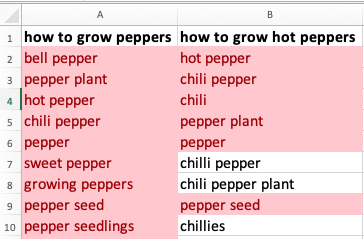A solid content brief is important for getting quality results. Unlike humans, computers struggle to deal with ambiguity, which brings us to our first tip.
Use very specific subheading topics.
For example, an article about growing tomatoes would likely have a section on the best time to plant seeds. While a human can make the connection that you’re talking about tomato seeds, the software doesn’t. So the topic will need to be phrased as the best time to plant tomato seeds.
Note that content brief subheadings have both a topic and a title. So while the topic may be best time to plant tomato seeds, you may want the editorial title to read the best time to plant seeds.
You can make this adjustment in Step 3 – Reviewing and Editing a Content Brief.
Look at the Competitive Heatmap
There are two ways the heatmap can help build a better brief. Use it to discover content gaps. Are there any topics that the competition is missing out on covering? Consider using that as a subheading topic to set your content apart from the rest of the pack.
Second, look at the pages in the heatmap with a high Content Score that matches your target intent. Examine those pages to see what subheadings they use as inspiration for your own.
Provide questions that are closely related to the subheading’s topic.
Both human writers and our natural language generation engine will yield a better result if the questions for each subsection are highly relevant to that specific section.
Here are two example questions for our hypothetical section on the best time to plant tomato seeds:
- When is the best time to plant tomato seeds indoors?
- When is the best time to plant tomato seeds outdoors?
Notice how they’re hyper-specific? Unlike a human, the natural language generation (NLG) engine needs to know these questions are specifically about tomato seeds.
Providing these questions is optional as MarketMuse offers its own list of questions in the content brief, which you can edit in Step 3 – Reviewing and Editing a Content Brief. However, adding your own questions provides greater control over the end result, whether the output is human or NLG.
When Creating a Content Brief
Avoid Topic Overlap Within a Section
Using very similar concepts or terms within a section degrades the quality (i.e. sales and sale, link-building and link building). In a content brief create for a human writer, they can make adjustments to hyphens, plurals, and the like, but the NLG doesn’t. So make sure to remove those similar concepts.
Read How Optimize Handles Plurals and Other Issues. It explains how we handle this and why.
Avoid Subheading Topics Whose Topic Lists Overlap Excessively
MarketMuse generates a topic model for each subsection entered in Step 2 – Creating Sections of a Content Brief.
The degree to which each section’s topic model overlaps with one other affects the NLG output. There should be some overlap between sections since they are related. However, too much overlap results in repetition in the output of the NLG engine.

Take Advantage of Editing Your Brief
Editing gives you an opportunity to really hone in and refine the direction of your content. In the second step, where you create sections, MarketMuse offers some suggestions for questions that can be answered in your content. These recommendations are based on the focus topic of your article, as a whole.
When you edit your content brief, you’ll notice additional question recommendations for each subsection. These are more granular and based on the topic of that specific section.
Take a minute to review these questions to see which ones best address that section. Treat each section like its own mini-article.
